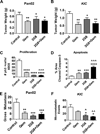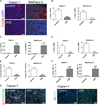Neutralizing murine TGFβR2 promotes a differentiated tumor cell phenotype and inhibits pancreatic cancer metastasis
- PMID: 25060520
- PMCID: PMC4167492
- DOI: 10.1158/0008-5472.CAN-13-1807
Neutralizing murine TGFβR2 promotes a differentiated tumor cell phenotype and inhibits pancreatic cancer metastasis
Abstract
Elevated levels of TGFβ are a negative prognostic indicator for patients diagnosed with pancreatic cancer; as a result, the TGFβ pathway is an attractive target for therapy. However, clinical application of pharmacologic inhibition of TGFβ remains challenging because TGFβ has tumor suppressor functions in many epithelial malignancies, including pancreatic cancer. In fact, direct neutralization of TGFβ promotes tumor progression of genetic murine models of pancreatic cancer. Here, we report that neutralizing the activity of murine TGFβ receptor 2 using a monoclonal antibody (2G8) has potent antimetastatic activity in orthotopic human tumor xenografts, syngeneic tumors, and a genetic model of pancreatic cancer. 2G8 reduced activated fibroblasts, collagen deposition, microvessel density, and vascular function. These stromal-specific changes resulted in tumor cell epithelial differentiation and a potent reduction in metastases. We conclude that TGFβ signaling within stromal cells participates directly in tumor cell phenotype and pancreatic cancer progression. Thus, strategies that inhibit TGFβ-dependent effector functions of stromal cells could be efficacious for the therapy of pancreatic tumors. Cancer Res; 74(18); 4996-5007. ©2014 AACR.
©2014 American Association for Cancer Research.
Conflict of interest statement
Figures







References
Publication types
MeSH terms
Substances
Grants and funding
LinkOut - more resources
Full Text Sources
Other Literature Sources
Medical
Molecular Biology Databases

